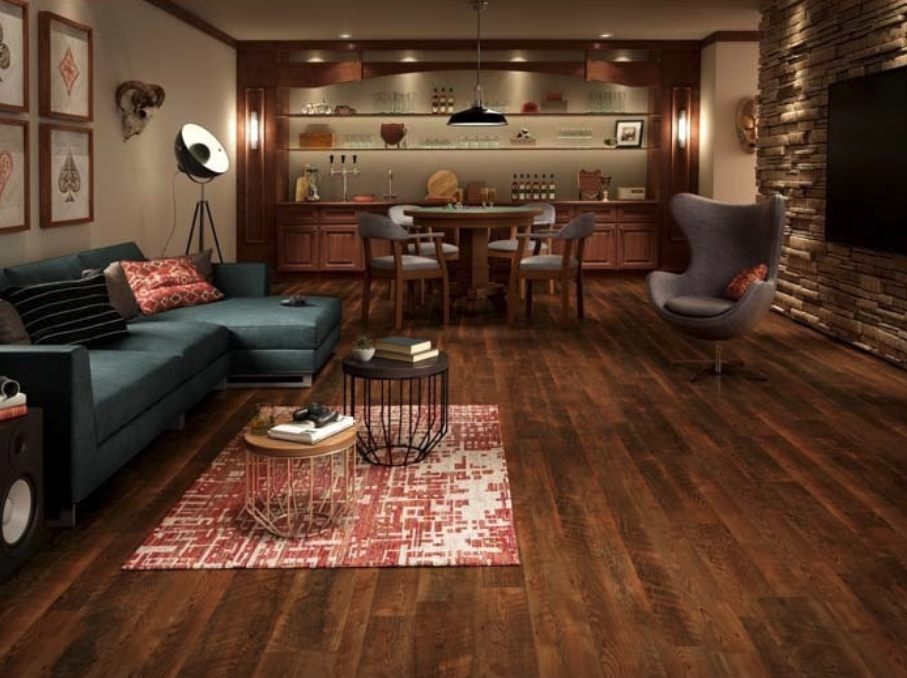Laminate Flooring Thickness Guide – All You Need to Know
Laminate is a flooring material you’ve seen and walked upon a thousand times or more. From residential spaces like busy kitchens to lobbies, waiting rooms and offices, laminate is a true leader when it comes to flooring.
That’s because laminate is a cost-effective solution that’s downright durable compared to some of its common competition. Add in the fact that modern laminate comes in tons of looks that can mimic more expensive materials like natural hardwood and stone and you may be singing the praises of laminate to anyone who will listen.
When it comes to choosing laminate flooring though, understanding the thickness required for your space, as well as how it can impact your installation, long-term durability and maintenance routine is vital though. Laminate thickness isn’t something most novices are too familiar with, however.
The good news is that we’ve put together a handy guide to help you understand more about laminate flooring and laminate thickness in general. Keep reading to get a grasp on choosing laminate flooring for your space today.
How is Laminate Flooring Made?
Laminate flooring is crafted using a multi-layer approach that provides a tough, resilient surface for commercial and residential use. Through heating and high-pressure, these layers are fused together to create flooring that’s incredibly durable and designed to last for a very long time with minimal care.
With laminate flooring, four layers are generally combined to create the product you’ll use in your space. Here’s how those layers look on their own:
• Bottom layer (4). Sometimes referred to as the backing layer, the bottom layer of laminate flooring provides stability to the completed laminate board.
• Inner core layer (3). The inner core layer, which is the thickest of all four layers, is typically made from MDF (medium-density fiberboard), HDF (high-density fiberboard) or particle board. This is the main structural component in vinyl flooring and makes up a significant amount of the weight of a vinyl plank or square when you hold it in your hand.
• Wear layer (2). The wear layer, typically made of melamine, is put in place to help the complete construction of your laminate tile or plank resist wear. Most wear layers are coated to help prevent water damage as well.
• Decorative layer (1). This is the layer that you see when walking on a laminate floor. It may be designed to look like wood, natural stone or have a completely unique pattern.
What is Laminate Thickness?
The concept of laminate thickness can be a confusing one. If you’re new to laminate flooring, you’d probably guess that this measurement is the total depth of a laminate plank or tile.
The reality is that laminate thickness is measured in millimeters and defined by the thickness of the inner core layer only. The cladding on some laminate planks shouldn’t be added when measuring the total thickness of any given material. While you can find a variety of products on the market today, laminate flooring is between 6mm and 12mm in thickness, with 6mm styles being quite thin and 12mm designs on the very heavy side.
Why is Choosing the Right Thickness for Laminate Important?
Most people imagine that ultra-thick laminate flooring must be the best, most durable option. While this sounds true on the surface, the fact is that thickness isn’t the only factor when it comes to durability. In fact, super-thick laminate flooring isn’t that much more durable than a well-made thinner product in most cases.
What thicker laminate flooring provides is a different look and feel than thinner laminate material. This may or may not be the look that you’re after.
When it comes to durability, a firm, strong inner core layer is by far the most important aspect – much more important than thickness, in fact.
Advantages of Thick Laminate Flooring
12mm thick boards and an AC3 durability rating for high residential and light commercial traffic. Featuring Lamton Laminate – Marquis Collection. SKU: 15272202
Now that you know ultra-thick laminate flooring isn’t indestructible, there are still a few advantages of thick laminate to be aware of. Those include:
• Thick laminate can withstand extremely high foot traffic better than thinner laminate of the same quality on average. This is particularly important for high traffic commercial spaces.
• Very thick laminate can feel more like other flooring materials, including natural wood. This may be of great importance to you if you choose a laminate product designed to mimic another material like wood flooring.
• Heavy, thick laminate can reduce environmental noise, which can be a big benefit in high-traffic spaces and sensitive environments like doctor’s offices or health care facilities.
• It can be a little more forgiving when it comes to installation. This is key if you’ve got a very difficult space or you’re considering doing the installation on your own without professional help.
Disadvantages of Thick Laminate Flooring
Thick laminate flooring is often a great choice for both residential and commercial spaces. There are a few disadvantages to be aware of though. Those include:
• Cost. Thicker laminate tends to be more expensive than thinner laminate flooring. In some spaces, this added cost may not be worth it to you.
• Environmental impact. Thicker laminate flooring may take longer to degrade, and since it requires more material, it does pose more environmental difficulty. However, in spaces where long-term durability matters, the extra environmental impact may be offset since the laminate will likely stay in place longer.
Advantages of Thin Laminate Flooring

The beveled edges provide a realistic and natural hardwood appearance. Featuring Lamton Laminate – 7mm AC3 – Freedom Collection. SKU: 15274534
Thick laminate flooring is often a go-to choice for builders and designers. Thin laminate flooring has its place too, however. Here are some of the advantages of using thin laminate flooring:
• Cost. Thin laminate flooring will cost considerably less, making it an excellent choice for budget-conscious buyers. It’s also a smart buy for back rooms or stock areas where customers won’t go in commercial spaces.
• You can install thinner laminate over the top of existing concrete. This makes installation much easier. Installing thin laminate over concrete also results in very durable flooring that may rival thicker laminate on top of a different type of subfloor.
• It’s a better environmental choice since less material is used to make thinner laminate. This is especially true for light-use spaces where durability isn’t a major concern or you’re dealing with a concrete subfloor that provides more than enough strength.
Disadvantages of Thin Laminate Flooring
Thin laminate flooring, as cost-effective as it can be, isn’t right for every project. Here are some of the disadvantages you’ll want to keep in mind if you’re thinking about installing it in your home or place of business:
• It’s harder to work with than thicker laminate flooring. This is very important if you’re considering a DIY installation in your home.
• Thin laminate thrives on a solid subfloor and is often best on top of concrete. Subfloors that are perfectly level can leave your thin laminate vulnerable to peeling and damage.
• It may not last as long in high-use spaces. Over time, lots of foot traffic can wear down thin laminate flooring, leading you to replace it more often.
• Thin laminate may not feel as good under your feet as thicker laminate. Many people describe thin laminate as having a somewhat plastic-like feel underfoot. This may not be a problem in high-use spaces or work areas, however.
Which Laminate Flooring Thickness is Best for Me?
Right before ordering laminate for a residential or commercial space, many people have one basic question: What is a good thickness for laminate flooring for my intended purpose. Like most things, it truly does depend on the application.
Here are a few common laminate thicknesses and what you should know about them:
• 6mm laminate. A more cost effective option of laminate flooring. It is also more environmentally friendly and can be installed over concrete. That being said, it isn’t as durable and shouldn’t be used for high traffic areas or commercial applications.
• 8mm laminate. Slightly better durability than 6 or 7mm, but it might not have the same pleasant feel as 10mm laminate. It is also a cheaper option than the thicker planks, but depending on the application it might need to be repaired more often.
• 10mm laminate. Often considered the sweet spot when it comes to laminate thickness, 10mm laminate offers durability, a good feel underfoot and low noise even in high-traffic spaces. Reasonable pricing generally makes 10mm laminate a smart buy as well.
• 12mm laminate. Extra-heavy 12mm laminate offers many of the same benefits as 10mm laminate, though it typically costs a little more. 12mm laminate is often reserved for high-traffic commercial spaces like hospitals since every bit of durability matters in such busy spaces. Budgets also tend to be higher for long-term commercial projects, so the price difference is often less of a factor.

Shop All Sized Laminate at BuildDirect!
Choosing the right laminate thickness, plank size or tile width can be tricky. After all, you just want your space to look and feel great. The good news is that our trained representatives are here to help.
With all laminate sizes and styles available, we can help you find the perfect laminate flooring option for your home or business. Reach out today and we can help you get started.



